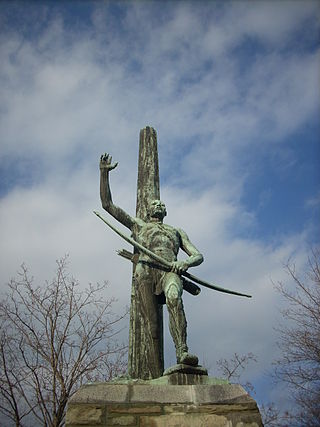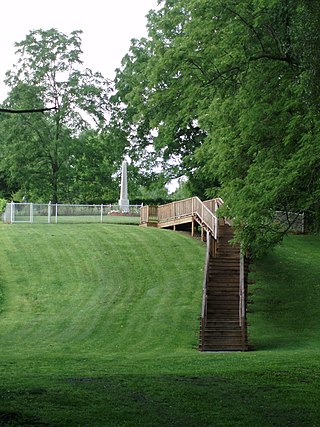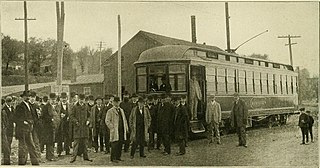Related Research Articles

The Finger Lakes are a group of eleven long, narrow, roughly north–south lakes located directly south of Lake Ontario in an area called the Finger Lakes region in New York, in the United States. This region straddles the northern and transitional edge of the Northern Allegheny Plateau, known as the Finger Lakes Uplands and Gorges ecoregion, and the Ontario Lowlands ecoregion of the Great Lakes Lowlands.

Seneca County is located in the U.S. state of New York. As of the 2020 census, the population was 33,814. The primary county seat is Waterloo, moved there from the original county seat of Ovid in 1819. It became a two-shire county in 1822, which currently remains in effect and uses both locations as county seats although the majority of Seneca County administrative offices are located in Waterloo. Therefore, most political sources list only Waterloo as the county seat. The county's name comes from the Seneca Nation of the Haudenosaunee (Iroquois), who occupied part of the region. The county is part of the Finger Lakes region of the state.

Schuyler County is a county in the U.S. state of New York. As of the 2020 census, the population was 17,898, making it the second-least populous county in New York. The county seat is the village of Watkins Glen. The name is in honor of General Philip Schuyler, one of the four major generals in the Continental Army in the American Revolutionary War. The county is part of the Southern Tier region of the state.
Catharine is a town in Schuyler County, New York, United States. The population was 1,656 at the 2020 census. The town is one of two in the county named after Catherine Montour, a Native American interpreter and leader in the area. The Town of Catharine is in the southeastern part of the county and is north of Elmira.
Dix is a town in Schuyler County, New York, United States. The population was 3,723 at the 2020 census.
Montour is a town in Schuyler County, New York, United States. The population was 2,323 at the 2020 census. The town is one of two towns in the county named after Catherine Montour.

Montour Falls is a village located in Schuyler County, New York, United States. The population was 2,714 at the time of the 2020 census. A waterfall at the end of West Main Street gives the village its name. The name "Montour" is derived from Queen Catharine Montour, a prominent Native American woman of Seneca Indian heritage who lived at the village site in the 18th century.
Odessa is a village in Schuyler County, New York, United States.
Romulus is a town in Seneca County, New York, United States. The population was 3,203 at the 2020 census. The town is named after the mythical founder of Rome, Romulus, a name assigned by a clerk with an interest in the classics. It is located in the central part of the county, northwest of Ithaca, New York.

Painted Post is a village in Steuben County, New York. The village is in the town of Erwin, west of the city of Corning. The population was 1,809 at the 2010 census. The name comes from a Seneca carved post found by explorers at the junction of three local rivers. Corning-Painted Post Airport (7N1) is west of the village.

Waterloo is a village and primary county seat of Seneca County, New York, United States. The population was 5,171 at the 2010 census and is now the most populated village in Seneca County. The village is named after Waterloo, Belgium, where Napoleon was defeated. It is the primary county seat of Seneca County, with the other being Ovid as part of a two-shire system established in 1822. Most of the county administrative offices are located in the village. Therefore, many political sources only list Waterloo as the county seat.

The 1779 Sullivan Expedition was a United States military campaign during the American Revolutionary War, lasting from June to October 1779, against the four British-allied nations of the Iroquois. The campaign was ordered by George Washington in response to Iroquois and Loyalist attacks on the Wyoming Valley, German Flatts, and Cherry Valley. The campaign had the aim of "taking the war home to the enemy to break their morale." The Continental Army carried out a scorched-earth campaign in the territory of the Iroquois Confederacy in what is now western and central New York.
Catharine Montour, also known as Queen Catharine, was a prominent Iroquois leader living in Queanettquaga, a Seneca village of Sheaquaga, informally called Catharine's Town, in western New York. She has often been confused with Elizabeth "Madame" Montour, her aunt or grandmother who was a noted interpreter and adviser to the governor, and with "Queen Esther" Montour, usually described as her sister. Several places in western New York were later named in her honor, after most of the Iroquois had been forced to cede their lands and were driven out of the region.

The Boyd and Parker ambush was a minor military engagement in what is now Groveland, New York on September 13, 1779, during the American Revolutionary War. A scouting patrol of the Sullivan Expedition was ambushed by Loyalist soldiers led by Major John Butler and their Seneca allies led by Cornplanter and Little Beard.
Catharine Creek is a roughly 15-mile-long (24 km) stream that flows through Chemung and Schuyler counties in New York. The creek, named after Catharine Montour, is a major tributary to Seneca Lake.

Goiogouen, was a major village of the Cayuga nation of Iroquois Indians in west-central New York State. It was located on the eastern shore of Cayuga Lake on the north side of the Great Gully Brook, about 10 miles (16 km) south of the large 17th-century Cayuga town of Tiohero; and approximately along the southern line of the modern-day township of Springport, New York. It was located about four miles (6 km) north from Chonodote, the present-day location of the village of Aurora, New York and about two miles (3 km) south of the village of Union Springs, New York.
Little Beard's Town, also known as Chenussio and "Genesee Castle", was a powerful Seneca town in the Genesee River Valley near modern Leicester in Livingston County, New York, where Cuylerville stands today.
The Montour family is a family of Native-American and French descent that was prominent in colonial New York and Pennsylvania before and during the American Revolution. Because of the Iroquois practice of reckoning descent through the female line, the family is known as "Montour" after the matriarch.

The line of the Elmira & Seneca Lake Railway Co. from Horseheads, New York to Seneca Lake was opened for operation on June 19, 1900.
Canoga is a hamlet in the Town of Fayette, Seneca County, New York, United States, along Cayuga Lake. It is located seven miles (11 km) southeast of the hamlet of Seneca Falls, at an elevation of 449 feet. The primary cross roads where the hamlet is located are N.Y. Route 89 and Canoga Road.
References
- ↑ New York State Museum (1908). Report Part 3. p. 203. Retrieved Nov 23, 2015.
- ↑ Tanner, Helen Hornbeck; Adele Hast; Jacqueline Peterson; Robert J. Surtees; Miklos Pinther (1987). Atlas of Great Lakes Indian History. University of Oklahoma Press. p. 75. ISBN 0-8061-2056-8.
42°21′N76°50′W / 42.350°N 76.833°W